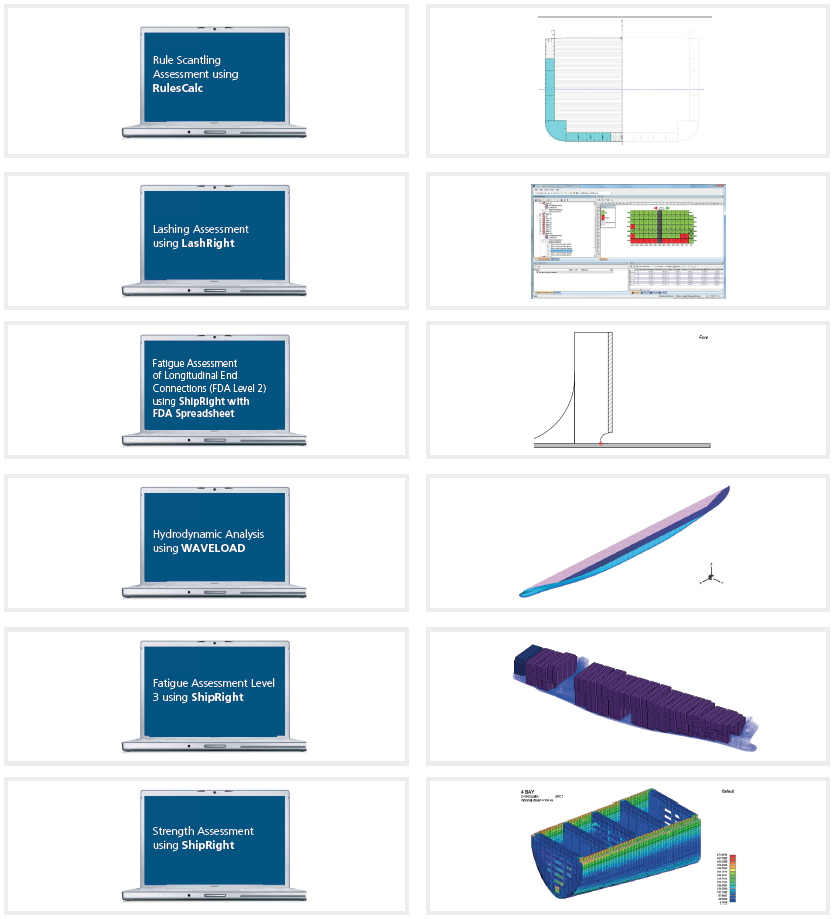Steps to classification
Rule Scantling Assessment
The traditional strength assessment of a hull is to use beam theory. The hull is assessed as a girder loaded in bending and shear, and each deck, bulkhead and shell as separate boundaries exposed to a pressure differential. Although simplified, it is relatively quick to iterate designs with this assessment and it can provide a good estimate of the final lightship steel weight necessary for structural integrity. The assessment of operational, inspection / maintenance, and flooded loading conditions can be assessed with the RulesCalc software. The Rule scantlings assessment cannot capture the interaction of transverse and longitudinal structures, so a final confirmation is required by finite element analysis. This is carried out in Step 4 and uses the Rule-compliant scantlings determined in RulesCalc as its input. This level of detail significantly reduces the amount of re-work needed when the design is assessed with finite element analysis.
Lashing Assessment
LashRight calculates the forces acting on containers, twistlocks and lashing rods and assesses the results against Lloyd’s Register’s container stowage and securing requirements. Early indication of possible lashing failures or improper stack weight distribution helps prevent containers from being damaged or lost overboard. LashRight enables multiple scenarios to be examined, helping you to manage the risk of failure. Designed to be fast and intuitive, LashRight is tailored specifically to the needs of people designing, appraising and investigating container stowage arrangements and lashing systems. The software covers industry standard containers and lashing equipment or you can define your own equipment and container specifications and add them to the software’s library. Ship motions and wind loads are calculated automatically in accordance with the Rules, or they can also be user-defined. The results from LashRight include calculated racking, shear and maximum and minimum compressive forces in the containers, and the forces in each lashing component.
Strength Assessment
In order to confirm that the hull structure will not yield or buckle in-service, a strength assessment is required. This is carried out by finite element analysis using a three-dimensional model. Using a finite element model allows complex geometries and loading distributions to be analysed, which otherwise cannot be represented by beam theory. The pre and post processor for the strength assessment is the ShipRight software, which processes finite element models and results in the NASTRAN format. The assessment can be carried out on both three-hold and full ship length finite element models.
Fatigue Assessment of Longitudinal End Connections
Due to the nature of their construction and cyclic environmental loads in-service, the hulls of ship units are susceptible to cracks forming and propagating. These cracks, if not addressed, could lead to total loss of structural integrity. To help mitigate this, a fatigue assessment is required to be carried out at the design stage to ensure that the likelihood of cracks initiating is at a low level. ShipRight FDA Level 2 employs an advanced spectral fatigue method to assess the fatigue damage of Longitudinal End Connections. For a typical vessel the procedures require over 5000 critical fatigue locations to be assessed; ShipRight FDA Level 2 software provides a fast and effective tool to perform this task. It uses a beam theory model of the hull combined with stress concentration factors to represent the level of pressure at the connections. The short-term fatigue damage is determined for each sea state from the trading wave environments.
Hydrodynamic Analysis
In order to assess the strength and fatigue resistance of a hull, it is necessary to know how the vessel responds to waves. The vessel will experience loads, which will cause it to deform and accelerate. These loads and accelerations can be determined by a hydrodynamic analysis using the WAVELOAD software, which is a boundary element potential flow code. The loads and accelerations are determined for individual waves of defined amplitude, frequency and heading relative to the vessel.
Fatigue Assessment Level 3
The FDA3 analysis is a first-principles direct calculation spectral fatigue analysis procedure applicable to any structural detail. The ship’s motions and loads determined from WAVELOAD are combined with the structural response, obtained using finite element analysis procedure, for a large number of discrete wave-induced load cases from specified trading routes. ShipRight trading routes, which are a direct function of the ship type, have been determined from statistical analyses of world-wide trading patterns. Alternatively a user defined wave environment, using specific trading patterns specified by the owner and builder, may be used. The fatigue performance results are provided as deterministic accumulated fatigue damage for the given service life calculated using a design S-N curve that represents a 97.5% probability of survival.
